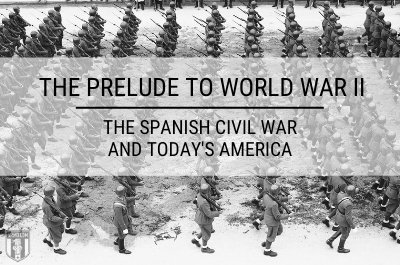
America is definitely not Europe, but we can find a number of parallels between European history and contemporary America. For example, we’ve previously written about the Italian Years of Lead as a possible template for urban unrest and low-level inter-tribal warfare in the United States. Another example of how things might play out in the United States is the Spanish Civil War.
The Spanish Civil War is known to historians, amateur and professional alike, as the “dress rehearsal for the Second World War.” It is so termed because it pitted one side – which was equipped, armed and funded by Europe’s fascist regimes (Germany and Italy) – against a government largely funded and propped up by the Soviet Union. However, it is worth noting that General Francisco Franco’s nationalist forces were not themselves fascist (though there were fascists within their ranks) and that Spain remained neutral during the Second World War, later becoming a close ally of the United States in the fight against Communism internationally.
While there are few perfect analogs to be found anywhere in world history, there are parallels between the contemporary domestic political situation in the United States and the period immediately before and during the Spanish Civil War. And while the situation in the United States might play out in a much similar way to the Spanish Civil War, it is worth noting that our previous Civil War was the bloodiest in human history. There is little doubt that a Second American Civil War would not be significantly more destructive.
Prologue: The Situation in Spain Prior to the Civil War
As we talk about the leadup to the Spanish Civil War, the situation will begin very much unlike modern-day America, however, it will become more like the contemporary domestic situation as time goes on.
The main difference, of course, is that Spain was a monarchy for almost all of its existence until 1931. A republic was briefly declared during the years 1873 and 1874, but it didn’t have much staying power and ultimately was not a transformative government in Spain. Following the First World War, the corrupt central government of Spain became increasingly unpopular and a military dictatorship, that of Miguel Primo de Rivera y Orbaneja, 2nd Marquess of Estella, 22nd Count of Sobremonte, arose. This fell in 1930, along with the abdication of the deeply unpopular King Alfonso XIII.
This led to the creation of the Second Spanish Republic and a new constitution in 1931. It was a radically leftist constitution in a largely conservative and Catholic country. Women’s suffrage, civil marriage, compulsory universal education, the nationalization of Catholic Church properties, the prohibition of Catholic religious orders from teaching in schools (and the Jesuit order entirely), as well as a provision allowing for the nationalization of any property that was for the “public good” were all components of the new Spanish constitution. In many ways it resembled the constitution of Weimar Germany, in that it was an attempt by the left to radically remake a country through constitutional means.
The first election saw leftist elements firmly in the saddle, but the second, in 1933, was a major victory for forces of the right. However, because the conservative party had won a plurality in the parliament, and not a majority, the left-wing president of Spain invited the centrist party to form a government. Meanwhile the socialist government alleged electoral fraud, which caused them to become further radicalized. On the ground, a radical working-class movement became hostile toward the ostensibly left-wing government after the movement was suppressed violently by the military.
Continue reading The Prelude to World War II: The Spanish Civil War and Today's America at Ammo.com.